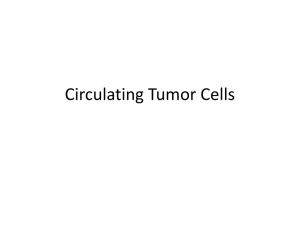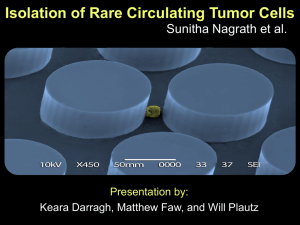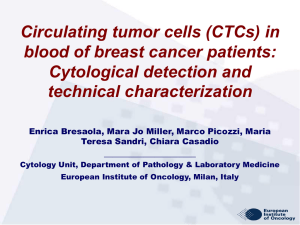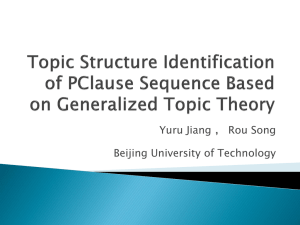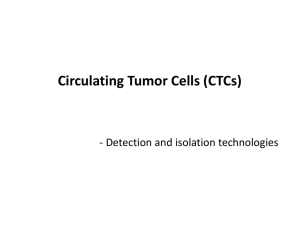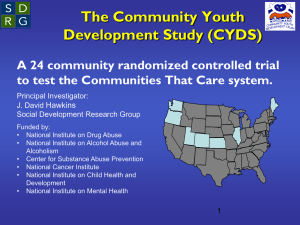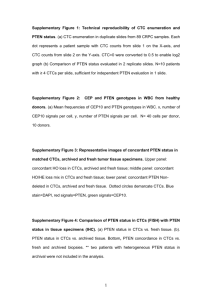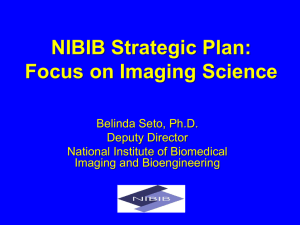- National Press Foundation
advertisement
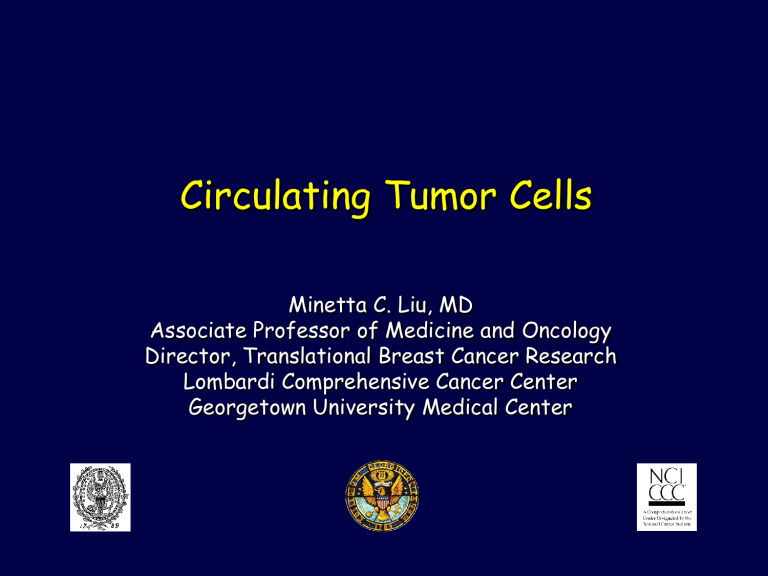
Circulating Tumor Cells Minetta C. Liu, MD Associate Professor of Medicine and Oncology Director, Translational Breast Cancer Research Lombardi Comprehensive Cancer Center Georgetown University Medical Center Era of Personalized Medicine • need an individualized approach to treatment to maximize benefit and minimize cost assessment of prognosis measurement of treatment benefit understanding of tumor biology Biomarker Strategies single biomarker assessment diagnosis prognosis direct therapy serial biomarker assessments prognosis direct therapy prediction Improving Outcomes • the enumeration and characterization of circulating tumor cells (CTCs) are useful in the clinical setting identification of CTC alterations in CTC levels CTC phenotype and genotype diagnosis prognosis prognosis prediction diagnosis prognosis direct therapy Origin of CTCs (Paterlini-Brechot et al. Cancer Letters 2007. 253:180.) Origin of CTCs • etiology disseminated cancer cells cancer stem cells bystander cells • rare cells in a dormant, nonproliferative state unaffected by chemotherapy unrecognized by the host immune system difficult to isolate Isolation of CTCs enrichment density gradient centrifugation filtration by size immunomagnetic labeling detection Alix-Panabieres et al. Clin Cancer Res 2008. 14:5013. characterization quantitation of growth factor expression gene expression profiling detection of epigenetic alterations Detection of CTCs • antibody based markers cytokeratins (CK8, CK18, CK19) epithelial membrane antigen (EMA) epithelial cell adhesion molecule (EpCAM) • nucleic acid based markers CK19 by RT-PCR mammoglobin by RT-PCR erbB2 by RT-PCR or FISH EGFR by RT-PCR Available Technologies for Isolation of CTCs Immunomagnetic Capture AntiEpCAM Ferrofluid Anti CD45-APC EpCAM Nucleus DAPI Nucleus DAPI CD45 CK AntiCK-PE Circulating Tumor Cell Leukocyte Immunomagnetic Labeling and Immunofluorescent Identification of Cells Immunomagnetic Capture composite intact tumor cells CD45 control cytokeratin DAPI Parylene Filter Microdevice (Zheng et al. J Chromatogr A 2007. 1162:154.) CTC Microchip (Nagrath et al. Nature 2007. 450:1235.) Immunomagnetic Labeling: Enumeration in MBC Clinical Parameters • CTCs in individuals with MBC detected in ~70% >5 per 7.5 mL blood in ~50% • CTCs in individuals without a malignancy detected in <10% >5 per 7.5 mL blood in 0% 71% 53% 50 45 49% 47% 46% 45% 40% 40 35% 35 32% 30 30% 29% 28% 25 26% 20 42% 38% 38% 36% 34% 34% 34% 27% 24% 23% 23% 23% 23% 22% 21% 21% 21% 21% 20% 15% 15 CTC threshold (per 7.5 mL blood) 20 15 14 13 12 11 10 9 7 6 5 1% 8 3% 1% 4 0 16% 8% 3 5 8% 6% 2 10 13% 13% 1000 55 58% 55% 100 60 61% 50 65 healthy volunteers (n = 145) benign diseases (n = 200) cancer, baseline (n = 177) cancer, first follow-Up (n = 163) 40 70 30 75 1 % patients at or above the CTC threshold Prevalence of CTCs IMC-001 • 177 patients (223 total) • metastatic breast cancer • measurable disease imaging blood 0 1 2 3 4 time points 5 6 IMC-001: CTCs at Baseline 100% 90% CTCs / 7.5mL at Baseline N (%) <5 CTC 89 (50%) >5 CTC 88 (50%) 80% Median PFS in Months (95% C.I.) 7.0 (5.6 to 8.9) 2.7 (2.1 to 4.4) 70% 60% 50% 40% 7.0 Months CTCs / 7.5mL Median OS in at Baseline N (%) Months (95% C.I.) <5 CTC 89 (50%) 21.9 (20.1 to 28.6) >5 CTC 88 (50%) 10.9 ( 7.0 to 15.2) 90% %Probability of Survival %Probability of Progression Free Survival Survival Free of Progression Probability 100% Cox Hazards Ratio = 1.8523 chi-square = 14.44 (p-value = 0.0001) 2.7 Months 30% 20% 80% 70% Logrank p < 0.0001 60% Cox Hazards Ratio = 2.3581 chi-square = 19.54 (p-value < 0.0001) 21.9 Months 50% 10.9 Months 40% 30% 20% Logrank p = 0.0001 10% 10% 0% 0% 0 5 n = 177 10 15 20 25 30 35 Time from Baseline (Months) 40 45 50 0 5 10 15 20 25 30 35 Time from Baseline (Months) 40 45 50 (Hayes et al. Clin Cancer Res 2006. 12:4218.) IMC-001: CTCs at 1st Follow-Up p value < 0.001 Cox Hazards Ratio = 2.4842 n = 177 p value < 0.001 Cox Hazards Ratio = 5.4537 (Cristofanilli et al. N Engl J Med 2004. 351:781.) IMC-001: Changes in CTC % probability of PFS 100% # patients (median PFS) 90% < 5 CTC at baseline & at 1st follow-up 81 (30.3 weeks) 80% decrease in CTC to < 5 at 1st follow-up 33 (32.9 weeks) > 5 CTC at 1st follow-up 49 (8.9 weeks) 70% ~7.0 months 60% p value < 0.0001 Cox Hazards Ratio = 1.6600 50% ~7.6 months 40% 30% ~2.1 months 20% 10% 0% 0 5 10 15 20 25 30 35 40 45 50 55 60 65 70 75 80 time from baseline (weeks) n = 177 (Cristofanilli et al. N Engl J Med 2004. 351:781.) IMC-001: CTCs and Imaging n = 83 (Cristofanilli et al. J Clin Oncol 2005. 23:1420.) IMC-001: CTCs and Imaging n = 138 (Budd et al. Clin Cancer Res 2006. 12:6403.) IMC-001: CTCs and Imaging n = 138 (Budd et al. Clin Cancer Res 2006. 12:6403.) LCCC Validation Study • 74 evaluable patients • metastatic breast cancer • measurable disease imaging blood 0 3 6 9 12 15 cycles 18 21 24 LCCC: CTCs and Imaging Treatment at Time of CTC Result OR 95% CI p-value Overall 6.3 (3.2, 13) <0.001 Chemotherapy 6.3 (2.9, 14) <0.001 Endocrine 8.9 (2.2, 35) 0.002 Treatment at Time of CTC Result OR 95% CI p-value Overall 3.1 (1.6, 5.8) 0.001 Chemotherapy 2.7 (1.2, 6.3) 0.02 Endocrine 5.2 (1.2, 23) 0.03 Treatment at Time of CTC Result OR 95% CI p-value Overall 4.9 (2.2, 118) <0.001 Chemotherapy 6.9 (3.0, 16) <0.001 Endocrine 2.9 (0.6, 14) 0.2 CTCs Drawn at the Time of Radiographic Imaging CTCs Drawn 3-5 Weeks Prior to Radiographic Imaging CTCs Drawn 7-9 Weeks Prior to Radiographic Imaging (Liu et al. J Clin Oncol 2009. 27:5153.) Recommendations for Use • to assess for progression in patients with measurable metastatic disease • to provide a guide by which to determine the timing of radiographic restaging studies • to assess the feasibility and timing of drug holidays in patients with stable disease and intolerable drug related toxicities Conclusions Response/Futility Marker • meaningful rate of detection • reliable threshold • correlation with clinical outcomes (validity) • ability to improve clinical outcomes (utility) CTCs – Present • clinical validity IMC-001 LCCC study • clinical utility assess disease status (with imaging) guide the timing of radiographic studies guide the timing of drug holidays guide systemic therapy (?????) Prospective Validation: Means to Improve Survival blood drawn at baseline prior to first-line chemotherapy CTC <5 CTC ≥5 blood drawn three weeks after the first chemotherapy dose Arm A monitor for PFS & OS CTC <5 eligible for other firstline chemotherapy trials SWOG S0500 CTC ≥5 R Arm B Arm C1 Arm C2 maintain first-line chemotherapy until progression maintain first-line chemotherapy until progression switch to alternate chemotherapy target n = 120 Prospective Validation: The Liquid Biopsy composite leukocyte control cytokeratin HER2 and SE17 FISH Probes nucleus Prospective Validation: The Liquid Biopsy paclitaxel and trastuzumab and lapatinib N = 400 paclitaxel and trastuzumab paclitaxel and lapatinib tissue blood CALGB 40601 0 2 4 6 8 10 weeks 12 14 16 ASCO Tumor Marker Guidelines • Circulating tumor cell assays as markers for breast cancer (Harris et al.J Clin Oncol 2007.33:5287.) THANK YOU
